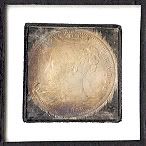Coin Daguerreotype! c. 1858
found while searching for something else, thought Id share...
also interesting...a daguerreotype image is a mirror image, so this photograph must have been made using a reversing prism.
Very rare and intriguing miniature English daguerreotype of a British coin that reads Victoria Dei Gratia. The date is slightly worn on the original coin and appears to be 1838 although it could easily be 1858. The image itself is a unique size measuring approximately 1 ¼”x 1.” It is housed in an English case with a modern white paper mount that measures 1 ½”x 1/ ½.” The outside of the plain leather case is 1 7/8”x 1 7/8.” The daguerreotype has some visible tarnish along with a few scratches. It is also slightly light in contrast although an electrolytic cleaning might provide some brightness. This is an interesting example of a genre that is not often seen.

also interesting...a daguerreotype image is a mirror image, so this photograph must have been made using a reversing prism.
Very rare and intriguing miniature English daguerreotype of a British coin that reads Victoria Dei Gratia. The date is slightly worn on the original coin and appears to be 1838 although it could easily be 1858. The image itself is a unique size measuring approximately 1 ¼”x 1.” It is housed in an English case with a modern white paper mount that measures 1 ½”x 1/ ½.” The outside of the plain leather case is 1 7/8”x 1 7/8.” The daguerreotype has some visible tarnish along with a few scratches. It is also slightly light in contrast although an electrolytic cleaning might provide some brightness. This is an interesting example of a genre that is not often seen.

0
Comments
Given the technical constraints of creating daguerreotype images, e.g. length of time necessary for exposure, it could have been that the imager was interested in coins, or was starting to learn his trade by imaging the coin (as the coin was not too likely to move) or both.
U.S. Type Set
Worry is the interest you pay on a debt you may not owe.
"Paper money eventually returns to its intrinsic value---zero."----Voltaire
"Everything you say should be true, but not everything true should be said."----Voltaire
Its not too difficult to photograph a coin using an early camera, basically the same as any other sytem...either a short lens with a lot of extension, or a longer lens with extension further from the coin. The Light is the issue, dag plates worked at about .5 ASA so an exposure would be about 1 minute. Probably used sunlight, and a reflector or two.
What is interesting is that the natural surface of the silver daguerreotype plate will tarnish down just the same as a MS silver coin. In fact, a circular dag of a silver coin could in fact eventually look exactly like the coin itself.....providing of course it was shot with an optical reversing system. either a prism or mirror.
Somewhere I have one of my "gift certificates" which I made years ago from my reenactment photo enterprise....that was a Lib. $20 gold reverse, shot full size and printed onto a CDV card. Good for $20 in trade!
Just finished this one up, sent it out a few days ago. This is a Lewis Daguerreotype Camera with a CC Harrison lens. This design dates from 1856 and was one of the first uses of bellows in a camera. It allows a longer extension...and is a camera which COULD make a coin photograph.
Seems though I remember reading that the first U.S. photographic plate was a mint bar of silver with a chemically treated surface. I presume that one did not survive.
<< <i><<The oldest surviving American Daugerreotype (1839) was taken at the second United States Mint in Philadelphia by Joseph Saxton through his upstairs office window.>>
Seems though I remember reading that the first U.S. photographic plate was a mint bar of silver with a chemically treated surface. I presume that one did not survive. >>
The part of about the mint bar of silver is possible, maybe even probable, but there is no written evidence which proves the point.
Do you have a larger image of that daguerreotype? It appears to actually be a farthing from what I can discern of the size of the queen's lock and the positioning of the "G" in Gratia. And yes, 1838 or 1858 would work as the Young Head design was minted from 1838 to 1860. Cheers.